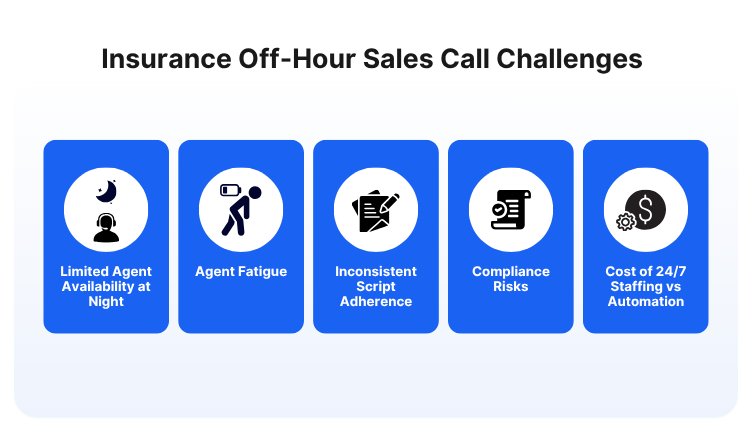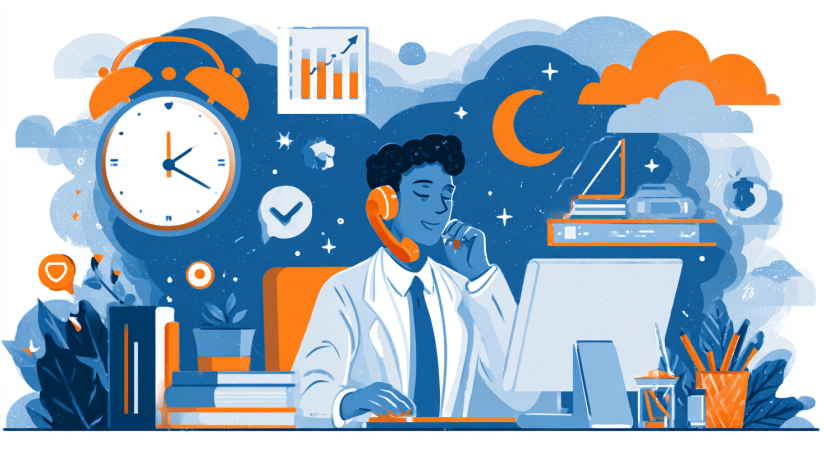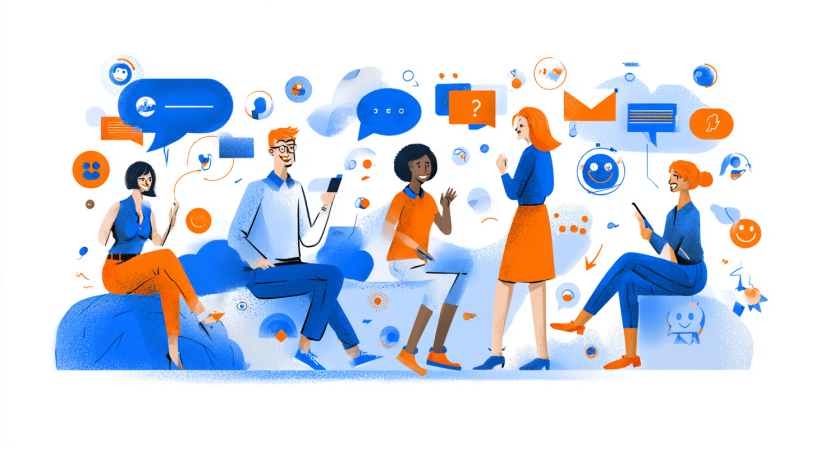In a world where insurance buyers don’t wait for standard business hours, answering the call at 9 AM just won’t cut it. Research shows that 57% of auto‑insurance customers actively shopped for new policies in the past year, the highest level on record.
Many of those shoppers dive in after dinner, on weekends, or during quiet hours when your desks are empty and your competitors are unavailable. That gap isn’t just a scheduling mistake; it’s a missed revenue stream.
In this blog, you’ll discover exactly who these after‑hours, high‑intent prospects are, why traditional 9‑to‑5 models fall short, and how leveraging the right system changes the game.
You’ll also walk through tools built for the night‑shift scenario, including how one platform from Convin handles live prompts, call analytics, and performance monitoring for off‑hour leads.
Capture after‑hours leads faster. See how Convin supports your team.
The After-Hours Buyer: Why Night-Shift Selling Works
In today’s insurance landscape, many purchase decisions don’t neatly fit into 9‑to‑5 windows. According to industry data, between 5:30 PM and 8:00 PM on weekdays, there’s a measurable uptick in quote requests, policy questions, and claims enquiries.
These moments matter: high‑intent visitors doing research, comparing options, ready to act, but you’re silent. That gap is exactly where off‑hours selling becomes both an opportunity and a competitive edge.
Which leads to the next question: what are the specific challenges of managing off‑hour calls in insurance sales, and how do they block conversion?
1. Who is the After‑Hours Buyer?
These are the prospects who research insurance plans after dinner, compare quotes on weekends, and are ready to act when most agents are off‑duty.
They aren’t browsing idly; they’re high‑intent. Industry data shows that 60% of insurers plan to increase AI investments next year, largely to capture non‑traditional buying windows.
In short, they engage outside standard hours, they expect responses quickly, and they will go with providers who meet them. Identifying and mapping these buyers is essential for any VP‑Sales leading a 24/7 strategy.
Understanding this after‑hours segment sets the stage; missing them means losing ready buyers, but meeting them means converting while competitors sleep.
2. Why Traditional 9‑5 Sales Models Miss These Opportunities
Standard insurance sales teams operate within typical hours. That leaves a gap when after‑hours buyers are active. According to a survey, over 80% of insurers now rank AI as a top strategic initiative.
In a 9‑5 model, you’ll see slower responses, fewer live agents, and less ability to engage leads who call late or respond to email at night. The consequence? High‑intent leads fall through cracks.
If your off‑hours strategy still relies solely on human staffing, you’re operating with a blind spot. You either need extended cover or AI‑augmented systems that work when humans don’t.
3. The Volume & Intent of Night Calls: What the Data Says
Analytics show that the insurance buyer’s behaviour is shifting. For instance, automation and digital tools in insurance reduce claims processing time by up to 50‑60%.
While the stat isn’t night‑specific, it underscores that when buying windows expands beyond 9‑5, speed and availability trump rigid schedule. Off‑hour calls represent an untapped volume and intent.
The data reveals the moment is ripe: if you can handle these contacts in real‑time, you’ll convert more of them, and your competitors likely won’t.
Turn night‑hour intent into wins. Equip your team with Convin

Challenges of Off-Hour Calls in Insurance Sales
Insurance teams are still catching up to the modern buyer’s schedule. A 2023 Forrester study found that customer satisfaction plummets when service responses take longer than 2 hours, especially outside regular hours.
That means delayed callbacks or missed night leads are directly costing you deals, and brand trust. This is why off-hour call challenges aren’t just operational, they’re strategic.
1. Limited Agent Availability and Fatigue During Off‑Hours
Late‑night or weekend staffing often means fewer agents, or agents operating with diminished focus after standard hours. That means slower response times, weaker handling of complex queries, and higher error rates.
When agents are tired or fewer in number, every call becomes a risk, missed upsell cues, overlooked compliance disclosures, or unscheduled follow‑ups.
Without healthy coverage and alert agents, off‑hour calls are more likely to fail than succeed. That gap opens the door for automation.
2. Inconsistencies in Script‑Adherence, Compliance Risk, Weak Coaching
Live agents outside peak hours may deviate from scripts, skip key disclosures, or respond ad‑hoc without support.
Meanwhile, regulatory risk in insurance is non‑negotiable. Quality assurance suffers when staffing is thin.
With weak coaching and little oversight during off‑hours, these matters accumulate. Worse, every mis‑handled call chips away at trust. Ensuring compliance, consistency, and coaching during off‑hours demands systems that monitor, prompt, and guide, not just live agents alone.
3. Cost and Headcount Implications of Staffing 24/7 Vs Automation
To cover nights with live agents means higher costs: overtime, extra headcount, supervision, and fatigue management. For many insurance firms, that’s impractical.
That’s where automation, especially call automation and AI‑driven support for agents, becomes a strategic lever. It enables coverage without exponentially rising staffing costs.
For a VP Sales, the conversation isn’t “staff more people” but “deploy smarter systems.” This leads to how AI tools make night‑shift selling feasible.
Close more night calls. Strengthen your team with smart support.
This blog is just the start.
Unlock the power of Convin’s AI with a live demo.

How AI Agent Insurance Tools Enable Night-Shift Success
AI is no longer optional in the insurance tech stack. According to McKinsey, AI-driven sales tools can increase conversions by up to 30% in financial services when deployed for lead prioritization and customer engagement.
That level of boost matters most when competition is asleep and your system is still closing deals.
1. Introducing AI in Insurance & AI for Insurance Agents
When we talk about AI in insurance and AI for insurance agents, we mean tools that guide, listen, analyse, and engage, often in real‑time. McKinsey highlights that only a few insurers have extracted outsize value from AI; the difference comes from a strategic full‑scale roll‑out.
For a VP Sales, that means it’s not enough to pilot AI; you need to embed it into the off‑hour strategy so that when the buyer calls, your system is ready.
AI for insurance agents isn’t a “nice‑to‑have” for night‑shift selling; it’s an essential enabler to close high‑intent buyers when humans aren’t at full strength.
2. Key Features of Convin’s Platform for Insurance
Here we list and explore the features of the tools from Convin tailored for insurance:
- Real‑Time Agent Assist: During live calls, agents get prompts, next‑best actions, upsell suggestions, and compliance cues. The system accelerates handling, reduces errors. According to Convin, agents using real‑time assist resolve calls up to 40% faster.
- Contact Center Conversation Intelligence: After each call, the system analyzes tone, sentiment, objections, and patterns. That means no blind spots; you’re not sampling, you’re scoring every call. Convin reports full‑cover QA and automated coaching.
- Voice of Customer Software: This tool aggregates what policyholders are saying, insights on pain points, language, and triggers. For night‑shift buyers, this means you understand their mindset and speak their language.
- Sales Calls Analytics Solution: Tracks performance metrics, identifies what works (and what doesn’t) after hours. For VPs, this gives transparency and agility.
These tools together shift night‑shift selling from “hope we respond” to “we engage proactively and consistently”, which is the difference between occasional wins and predictable conversions.
Boost off‑hour conversions. Try Convin’s performance tools today
Why This Matters for the Insurance Industry Now
In insurance, timing isn't a support metric; it’s a conversion lever. When high-intent buyers reach out after hours, most firms still operate in slow motion.
That's not just inefficient; it's expensive. The ability to engage, respond, and close during those late-night windows defines who leads and who loses ground.
For sales leaders, the goal isn’t to chase every call; it’s to ensure the right ones convert, even after hours. That means having systems in place that catch what humans can’t always cover: quality, consistency, and timing.
Convin gives insurance teams a way to close that gap, without adding more agents or compromising standards. If your team is ready to work smarter after dark, see how it fits.
Book your free Convin AI demo
1. What are the 4 stages of insurance claims?
The four stages of insurance claims are:
- First Notice of Loss (FNOL): The policyholder reports the incident.
- Claims Processing: The insurer gathers documentation and verifies coverage.
- Assessment & Investigation: The claim is evaluated, including possible fraud checks.
- Resolution & Payout: The insurer approves or denies the claim and processes payment.
2. How are insurance agents using AI?
Insurance agents use AI to streamline sales, improve claims handling, and increase responsiveness. With tools like AI agent insurance solutions from Convin, agents get:
- Real-time prompts during calls
- Automated quality checks
- Voice-of-customer insights
- Personalized renewal and upsell recommendations
This helps agents manage more interactions faster and with fewer errors.
3. Will AI replace insurance agents?
No, AI will not replace insurance agents but will support them. AI enhances agent performance by handling repetitive tasks, ensuring compliance, and improving decision-making. Platforms like Convin’s AI agent insurance tools allow agents to focus on complex cases and customer relationships while AI manages workflows, scripts, and data analysis.








.avif)